Key takeaways:
- Fire risk assessment requires vigilance, focusing on both environmental factors and human behaviors, such as clutter or improper storage, that can pose hidden dangers.
- Daily risk assessments are crucial for identifying hazards, fostering a culture of safety, and providing peace of mind for individuals in various environments.
- Utilizing checklists and digital tools enhances the assessment process, ensuring important factors are not overlooked and improving communication within safety teams.
- Engaging with staff and residents during assessments can uncover valuable insights, emphasizing the importance of community involvement in fire safety awareness.
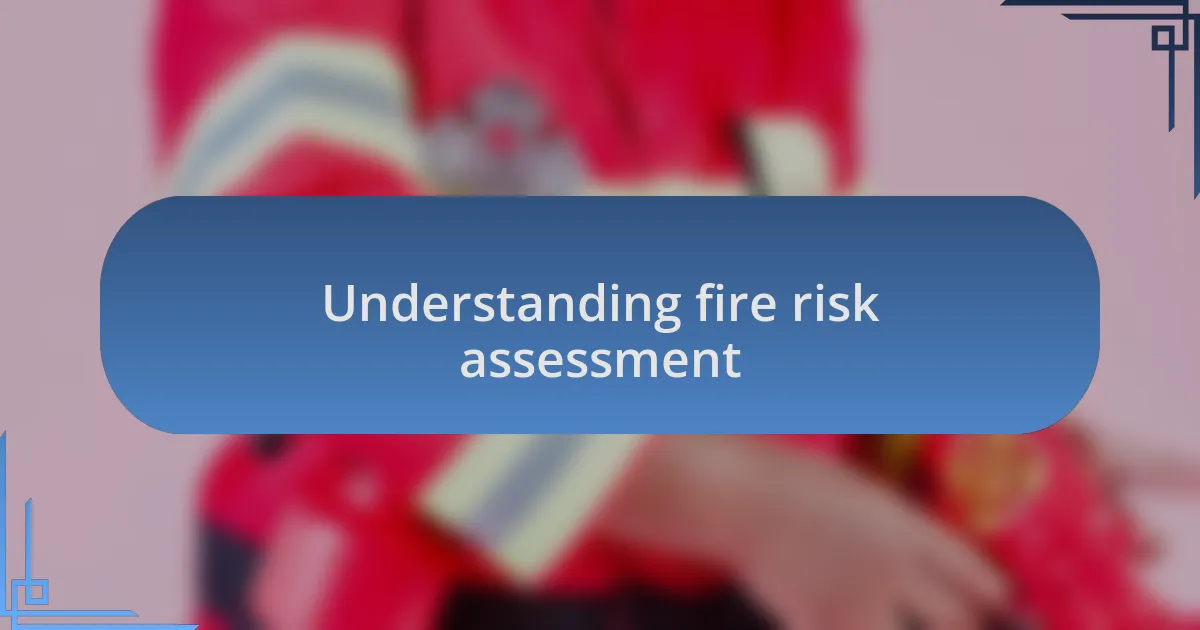
Understanding fire risk assessment
Fire risk assessment is an essential skill that goes beyond merely checking for potential hazards. I remember my first day on the job when I walked into a home that seemed perfectly normal, yet my gut told me otherwise. That day taught me that fire risks can often be hidden in plain sight, like outdated wiring or faulty appliances, which is why we must stay vigilant and observant.
When I assess fire risks, I focus not only on the physical environment but also on human behavior. Have you ever thought about how something as simple as clutter can become a significant fire risk? I once encountered a family with stacks of newspapers piled high near a heater. It struck me how easily a harmless habit could escalate into a dangerous situation, underscoring the need for education in fire prevention.
Understanding fire risk assessment also means recognizing the unique challenges of each environment. For instance, working in a commercial setting often involves complex fire dynamics due to increased occupancy and varied activities. Each assessment I conduct allows me to connect the dots between the layout, materials, and the people involved, making it a continuously evolving process that keeps me engaged and on my toes.
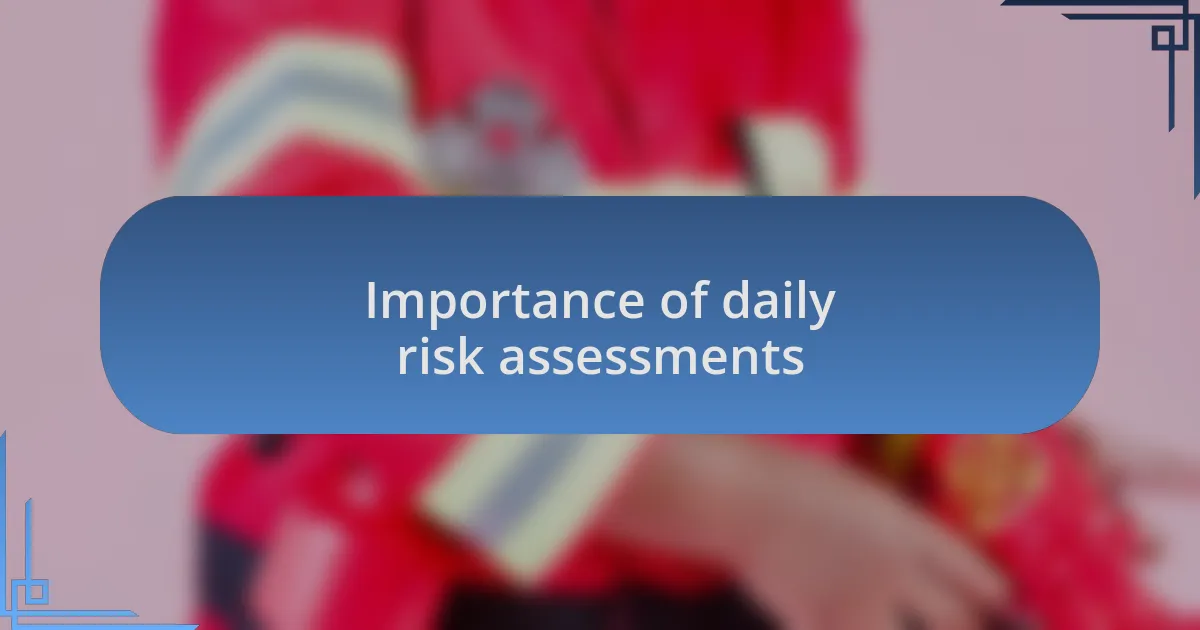
Importance of daily risk assessments
Daily risk assessments play a crucial role in fire safety, as they help identify evolving hazards in various environments. I recall a morning when I faced a routine check in a busy office. To my surprise, I discovered a storage room overflowing with cardboard boxes, blocking essential exits. It was a stark reminder that even seemingly innocuous spaces can harbor hidden dangers that require our attention.
The importance of these assessments lies not only in spotting potential dangers but also in fostering a culture of safety. I remember explaining to a local school about how their fire escape routes were cluttered with art supplies. This conversation made me realize how empowered individuals become when they understand the impact of their surroundings on fire safety. With daily evaluations, I can instill that empowerment, transforming passive awareness into proactive engagement.
Additionally, consistent risk assessments provide a sense of security for everyone involved. I often hear anxious parents expressing their concerns about fire safety in their homes. By conducting thorough daily checks and sharing my findings, I can alleviate those worries, showing them tangible steps they can take to protect their families. It’s incredible how a little knowledge can bring peace of mind and ultimately save lives.
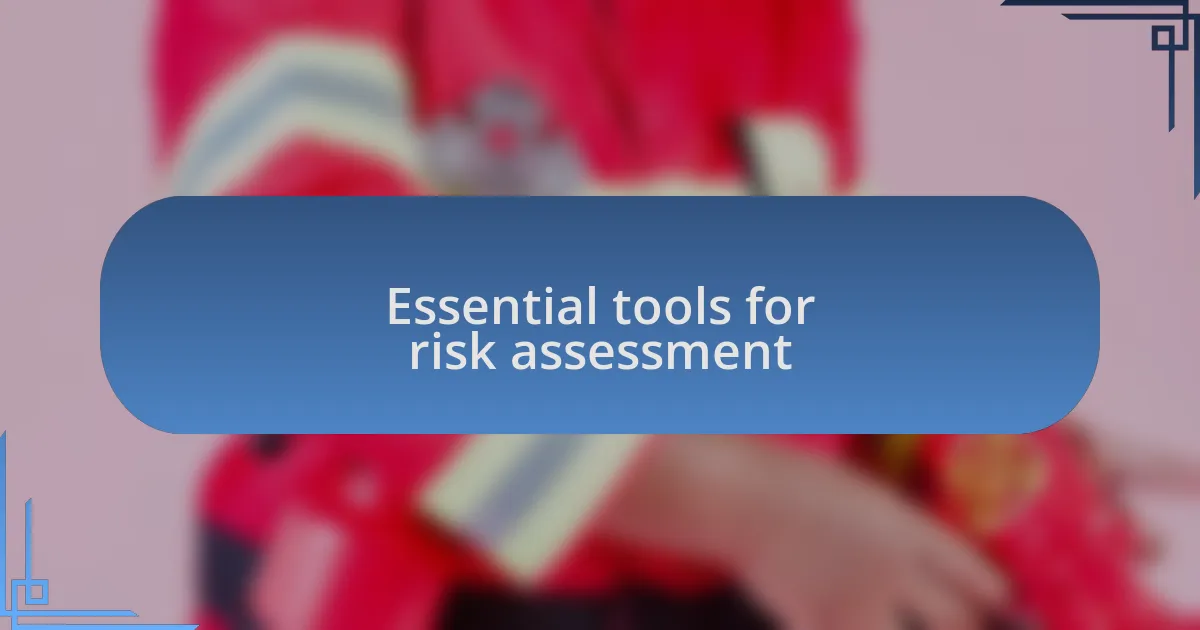
Essential tools for risk assessment
When it comes to assessing fire risks, I’ve learned that having the right tools at your disposal can make a significant difference. A reliable checklist is essential; it not only streamlines the assessment process but also ensures that critical aspects aren’t overlooked. I recall reaching an industrial site armed with my checklist, and, as I went through each item, it helped me discover poorly maintained fire extinguishers that might have otherwise gone unnoticed.
In addition to checklists, using digital tools can transform the way we approach risk assessments. I’ve started utilizing mobile apps designed for fire safety inspections, which allow me to document findings instantly and share reports with my team. It’s fascinating how technology can simplify communication; a quick tap on my phone can send alerts about fire hazards to the entire crew. Have you ever wondered how much time we save thanks to innovation in safety practices?
Lastly, I find that maintaining a set of reference materials is invaluable. A well-organized binder with guidelines on fire codes or emergency response procedures has proven to be a lifesaver during assessments. I can’t count how many times flipping through those pages provided clarity when addressing complex situations. It’s amazing how the right resources can boost not only our preparedness but also our confidence in making split-second decisions.

Steps to assess fire risks
When I begin assessing fire risks, the first step is to conduct a thorough walkthrough of the area. I typically start at the main entrance and methodically work my way through rooms and hallways, keenly observing for potential hazards. On one occasion, I noticed an overcrowded electrical panel, and that eye-opening moment made me realize just how critical a careful examination can be.
Next, gathering input from staff or residents is invaluable. I often ask them about any fire safety concerns they might have noticed or experienced. I once had a conversation with a building manager who mentioned unusual sparks from an appliance; this insight allowed me to identify the source and address it promptly. Have you ever considered how much people in the environment can contribute to your understanding of fire risks?
Finally, I prioritize evaluating the stored materials on-site. Knowing the types of flammable substances present can significantly influence the level of risk. I remember inspecting a warehouse filled with chemicals; the sheer variety of items made me realize how essential it is to familiarize myself with each product. By assessing these elements meticulously, I can determine the necessary precautions and ensure safety for everyone involved.
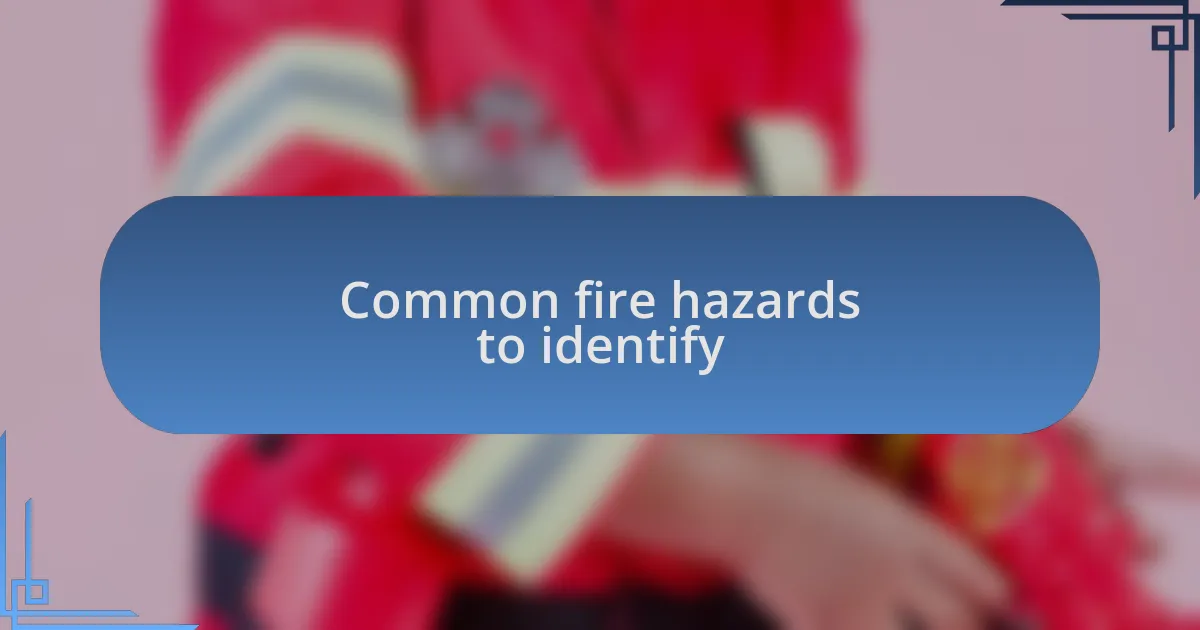
Common fire hazards to identify
When I’m on a fire risk assessment, I pay close attention to common fire hazards like blocked exits. On one occasion, during a routine check, I nearly missed a hallway cluttered with boxes. It struck me how easily a small oversight could escalate into a dangerous situation in case of a fire. Have you ever thought about how crucial clear pathways are for safe evacuation?
Another critical hazard I often identify is faulty wiring. I recall inspecting an older building where the wiring had frayed insulation and exposed wires. It was alarming to think about how many residents lived with that risk daily. This experience underscored the importance of regular electrical inspections and made me wonder if we often overlook our reliance on professional assessments until it’s too late.
Cooking equipment is another area of concern, especially in communal spaces. I remember visiting a daycare center where the kitchen was equipped with several appliances but lacked proper maintenance checks. The sight of grease accumulation near the stovetop was a stark reminder of how easily an unattended pan could spark a fire. How often do we consider the everyday activities that might lead to unforeseen dangers?
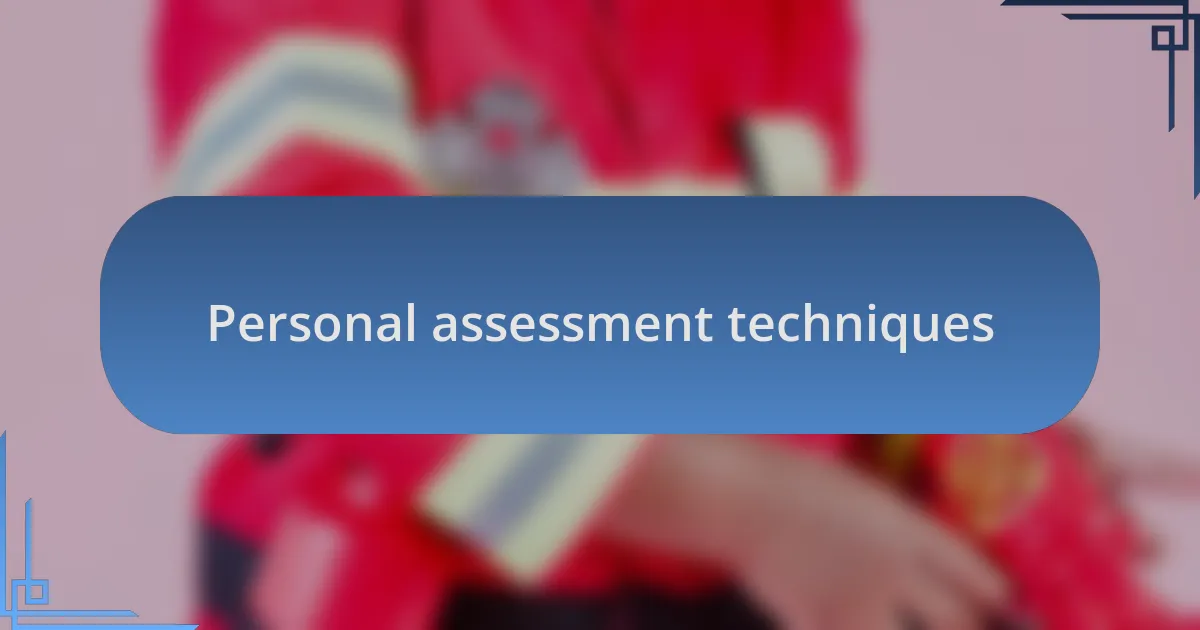
Personal assessment techniques
When assessing fire risks, I utilize a systematic approach that helps me stay organized and thorough. I begin with a walkthrough, taking note of potential hazards while asking myself how each area can be improved for safety. For instance, during one evaluation at an office, I spotted an overloaded power strip tucked behind a desk. It’s fascinating how a simple glance can reveal something potentially hazardous that most people wouldn’t notice.
I also employ a checklist tailored to specific environments, which ensures I don’t miss critical risk factors. Recently, while reviewing an industrial site, I found that many employees were unaware of the importance of keeping flammable materials away from heat sources. This realization not only provided me with a new perspective on employee training but also made me question how effectively we communicate safety protocols. Isn’t it surprising how a little education can significantly enhance awareness?
Lastly, I engage in discussions with staff or residents about their concerns and experiences. Connecting with people on a personal level has often led to unexpected insights. During a chat in a residential building, a tenant mentioned a recurring smell of smoke from a neighbor’s unit. This not only indicated a potential fire risk but also highlighted the vital role of community vigilance. Have you ever considered how fostering an open dialogue can be an essential tool in fire risk assessment?
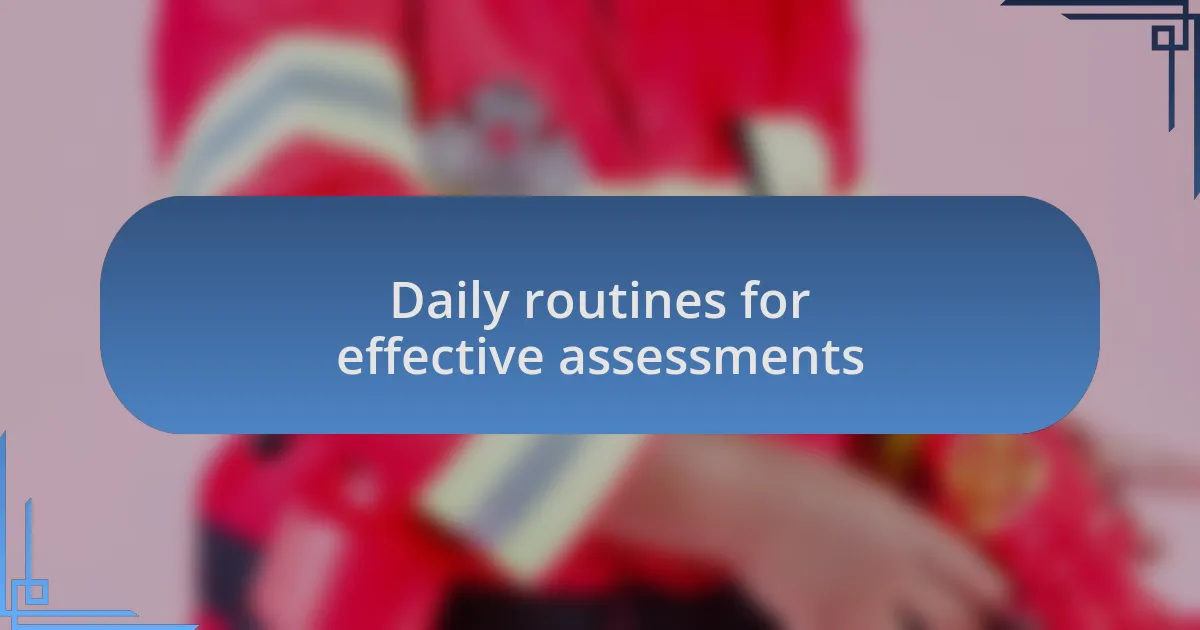
Daily routines for effective assessments
When it comes to my daily routines for effective assessments, I make it a point to arrive early and conduct a comprehensive site inspection. This quiet time allows me to scan the area without distractions, helping me to identify changes since my last visit. For example, I once discovered a fire exit obstructed by new furniture being moved in—a quick adjustment cleared the path and potentially saved lives. Isn’t it fascinating how awareness can dramatically shift the way we perceive safety?
In addition to my site inspections, I incorporate weather conditions into my assessments. On particularly windy days, I’m more alert to the risk of flying debris or downed power lines. I remember a sweltering summer day when I assessed a community event, and the high temperatures prompted me to discuss hydration and fire safety with the organizers. That simple observation made the event safer for everyone involved. How often do we consider the impact of external factors on fire risk?
Moreover, I dedicate time each day to review recent incident reports. This practice not only informs my current assessments but also helps me recognize patterns that might indicate systemic issues. Once, I stumbled across a pattern of minor incidents related to cooking safety in a local community center. This insight prompted me to conduct a workshop on kitchen safety—a proactive approach that I believe empowered the staff. Have you noticed how valuable it is to learn from the past to enhance future safety initiatives?